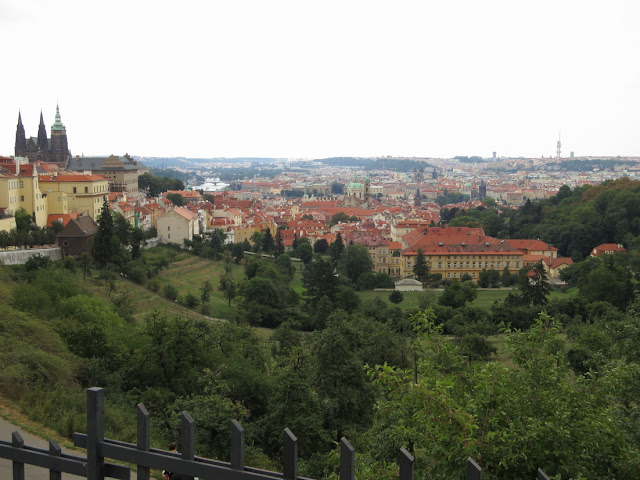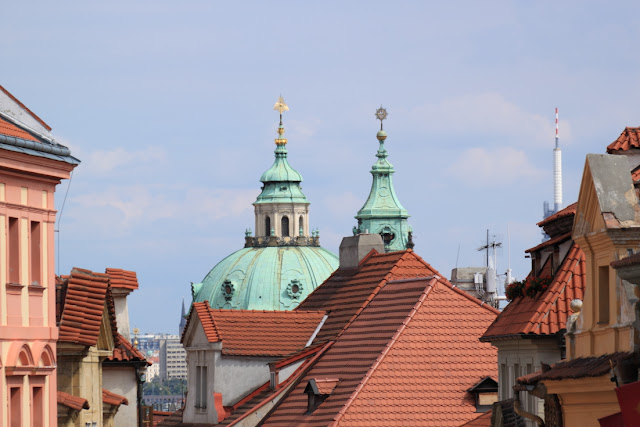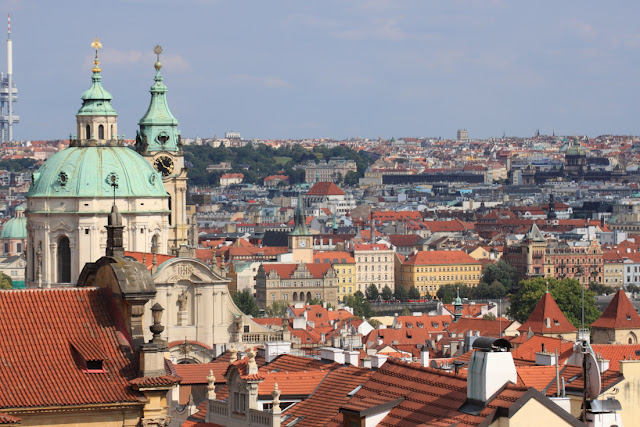I purchased the audio guide as part of the entrance fee (waste of money – didn’t say sh!te). Some time passed before it sunk in that the bones laden everywhere are in fact from real people centuries ago. In fact 40,000 are believed to have been buried in the chapel and its grounds one way of another which is quite extraordinary given the size of the area.
Basically the chapel is decorated all throughout with the bones of people whom have requested to have their remains enshrined in this chapel.
The story goes.... in 1278, Henry, the abbot of the Cistercian monastery in Sedlec, was sent to the Holy Land by King Otakar II of Bohemia. He returned with him a small amount of earth he had removed from Golgotha and sprinkled it over the abbey cemetery. The word of this pious act soon spread and the cemetery in Sedlec became a desirable burial site throughout Central Europe.
An ornamental chandelier had been constructed with every bone in the human body. Clever but not a masterpiece by any means. The four visible pyramids of bones (another one is kept underneath the chapel in the crypt) were eerie. Countless 1,000s of bodies contained in each - didn’t really know what to make of it all. Creepy, but intriguing, and it is still being used as a chapel. Many of the dead were killed during battles centuries go, with fractured skulls evidencing their abrupt demise.
One thing you will learn about the Czech Republic (and its former guises) is that it has been invaded and overthrown countless times over the centuries. There are few instances where the Czechs have successfully fought off an invasion. But to their credit, they still exist as a nation and went on to invent pilsner, the tucker f@#ker, soft contact lenses and toilet paper.
One recent event in history worth acknowledging (as it highlights the peaceful nature of the Czech people) is how the Russian communist reign came to an end in 1989 (the Velvet Revolution). This was a non-violent revolution against the communist party of Czechoslovakia. Following the successful overthrow, the acts of Jan Palach, who burnt himself alive in 1969 to protest against the demoralisation of the Czech people following the invasion by Russia in 1968 were recognised with the erection of a statue in his honour
Later that day I decided to join a beer tasting tour. I was somewhat sceptical (and hesitant) about the tour as I’d already frequented quite a few pubs and it was Saturday night so more people were likely to opt for the pub crawl tour at 8pm instead. Numbers were low (apparently a new record low), me and three couples. Interestingly one young couple was from Toronto and both were studying Opera at university. The other couples were from Germany and Poland.
Our guide Jon-Pierre, an American-German, had a booming voice that could be heard miles away. First stop was the Prague Beer Museum (Dlouha/Soukenicka Sts, just east of the main square) which has 30 beers on tap from micro-breweries around the country (was here the previous night). The beers range from your standard larger and pilsner, to amber ales, IPAs, dark beers, fruit flavoured and one that apparently tastes like dish washing liquid. The most expensive way to taste them, but the most efficient, is to buy a tasting tray of 5 or 10 150ml samples, about a euro per sample. A very popular option but sh!te for the waitress – she had to write down 32 beers between our group of seven. I can recommend the Demon amber ale.
At the next venue we had the Kozel dark beer – really like that one. Heavy on the carbs but not like a Guinness at all. The third venue was dinner and the most popular beer drunk in Czech Rep, Gambrinus. It’s a mainstream beer that was quite quaffable. Dinner was more impressive than the beer, the 1kg roasted pork knee with token salad, mustard and horseradish. Demolished! And cheap too at Kr200 = Eur8.00. And lucky last was more of a bar/club – don’t recall the beer we had. It wasn’t anything special that’s for sure.
Notable things to do and place to try:
- Whether you do this on purpose or not, walk around the old part of town and get lost along the rough cobbled streets and laneways, steering clear of the main tourist routes – these will become apparent quickly. Mind your step as the paths are uneven with many hazards.
- Take a tram north away from the city centre to either Stromovka park or further north to the botanic gardens and zoo.
- Walk across Karluv Most (bridge) to the west of Prague and make your way up to the top of Petrin’s hill for a good view over the city. Continue up and over the back of Petrin’s hill until you come to Strahov monastery (excellent views as well). Stop at the cathedral next and be sure to find the small vineyard in front of it for a great panorama of the city. Perhaps buy a bottle of beer beforehand to drink there or try their wine (not sure how good or bad it is). Great spot to watch the sunset from.
- Lokal Restaurant – seems to be a bit of an institution among locals and tourists (must be in a few guide books). Quality fare at slightly higher prices in a huge building that takes up the length of the block. Skip the spicy sausage entrée as it aint spicy at all. The roast pork with a mound of spinach and bottomless potato dumplings was very good but I was glad I ordered an entrée. Including a 0.5L beer the bill was still only A$14! A relatively expensive Czech restaurant mind you.
- For an authentic ancient Czech pub, stick your head into KRćMA on Ostecna St (near the Jewish quarter). I’m not sure how big it is as we only made it as far as the first room you enter after descending the candle flanked stairs underground. No tourists here. There small nook near the staircase had sheepskin lined seats. The wax remnants of many thousands of hours of candles burning were scattered all throughout. This would be a really cozy bar in the depths of winter, heated by pot belly fire-places (and candles).
- Steer clear of the miserable family that runs the Mystic Café on a stair case leading up to the cathedral area. Crooks. And Kr110 for a beer – you’ve got to be kidding. You shouldn’t pay more than Kr40-45 for 0.5L. Often it will only be Kr32-35.
- U Medvidka Restaurant (on Na Perstyne St). The restaurant has origins dating back to 1466. It is giant and runs like clock-work. The interior is completely decked out in wood. Huge portions of food are flying past me at affordable prices (it’s all relative). The half duck looks brilliant. I was on my last Krowns and had been told to try Kudo, a Czech dish as entrée which didn’t leave enough coin, or room in my stomach, for some duck action. So it was kudo (roasted barley with roast garlic, mushrooms and herbs – an interesting dish, needs to be eaten with something else), the pork schnitzel with potato salad (of course) and a dark beer. Definitely try this place. Another local institution.
- The Czechs don’t seem to be too adept at making cakes and pastries and the like, nor ice-cream, but if you do get a craving and are towards the south end of the city centre, head to Vaclavska (in the arcade off Spalena opposite the southern half of Karlovo Namesti, between Na Morani and Resslova). It is a local favourite and was busy with the fussy retirement crowd when I turned up mid-late afternoon.
In the mid 14th century, during the Black Death, and after the Hussite Wars in the early 15th century, many thousands were buried in the abbey cemetery, so it had to be greatly enlarged.
Around 1400, a Gothic church was built in the center of the cemetery with a vaulted upper level and a lower chapel to be used as an ossuary for the mass graves unearthed during construction, or simply slated for demolition to make room for new burials. After 1511, the task of exhuming skeletons and stacking their bones in the chapel was given to a half-blind monk of the order.
An ornamental chandelier had been constructed with every bone in the human body. Clever but not a masterpiece by any means. The four visible pyramids of bones (another one is kept underneath the chapel in the crypt) were eerie. Countless 1,000s of bodies contained in each - didn’t really know what to make of it all. Creepy, but intriguing, and it is still being used as a chapel. Many of the dead were killed during battles centuries go, with fractured skulls evidencing their abrupt demise.
One thing you will learn about the Czech Republic (and its former guises) is that it has been invaded and overthrown countless times over the centuries. There are few instances where the Czechs have successfully fought off an invasion. But to their credit, they still exist as a nation and went on to invent pilsner, the tucker f@#ker, soft contact lenses and toilet paper.
One recent event in history worth acknowledging (as it highlights the peaceful nature of the Czech people) is how the Russian communist reign came to an end in 1989 (the Velvet Revolution). This was a non-violent revolution against the communist party of Czechoslovakia. Following the successful overthrow, the acts of Jan Palach, who burnt himself alive in 1969 to protest against the demoralisation of the Czech people following the invasion by Russia in 1968 were recognised with the erection of a statue in his honour
Later that day I decided to join a beer tasting tour. I was somewhat sceptical (and hesitant) about the tour as I’d already frequented quite a few pubs and it was Saturday night so more people were likely to opt for the pub crawl tour at 8pm instead. Numbers were low (apparently a new record low), me and three couples. Interestingly one young couple was from Toronto and both were studying Opera at university. The other couples were from Germany and Poland.
Our guide Jon-Pierre, an American-German, had a booming voice that could be heard miles away. First stop was the Prague Beer Museum (Dlouha/Soukenicka Sts, just east of the main square) which has 30 beers on tap from micro-breweries around the country (was here the previous night). The beers range from your standard larger and pilsner, to amber ales, IPAs, dark beers, fruit flavoured and one that apparently tastes like dish washing liquid. The most expensive way to taste them, but the most efficient, is to buy a tasting tray of 5 or 10 150ml samples, about a euro per sample. A very popular option but sh!te for the waitress – she had to write down 32 beers between our group of seven. I can recommend the Demon amber ale.
At the next venue we had the Kozel dark beer – really like that one. Heavy on the carbs but not like a Guinness at all. The third venue was dinner and the most popular beer drunk in Czech Rep, Gambrinus. It’s a mainstream beer that was quite quaffable. Dinner was more impressive than the beer, the 1kg roasted pork knee with token salad, mustard and horseradish. Demolished! And cheap too at Kr200 = Eur8.00. And lucky last was more of a bar/club – don’t recall the beer we had. It wasn’t anything special that’s for sure.
Notable things to do and place to try:
- Whether you do this on purpose or not, walk around the old part of town and get lost along the rough cobbled streets and laneways, steering clear of the main tourist routes – these will become apparent quickly. Mind your step as the paths are uneven with many hazards.
- Take a tram north away from the city centre to either Stromovka park or further north to the botanic gardens and zoo.
- Walk across Karluv Most (bridge) to the west of Prague and make your way up to the top of Petrin’s hill for a good view over the city. Continue up and over the back of Petrin’s hill until you come to Strahov monastery (excellent views as well). Stop at the cathedral next and be sure to find the small vineyard in front of it for a great panorama of the city. Perhaps buy a bottle of beer beforehand to drink there or try their wine (not sure how good or bad it is). Great spot to watch the sunset from.
- Lokal Restaurant – seems to be a bit of an institution among locals and tourists (must be in a few guide books). Quality fare at slightly higher prices in a huge building that takes up the length of the block. Skip the spicy sausage entrée as it aint spicy at all. The roast pork with a mound of spinach and bottomless potato dumplings was very good but I was glad I ordered an entrée. Including a 0.5L beer the bill was still only A$14! A relatively expensive Czech restaurant mind you.
- For an authentic ancient Czech pub, stick your head into KRćMA on Ostecna St (near the Jewish quarter). I’m not sure how big it is as we only made it as far as the first room you enter after descending the candle flanked stairs underground. No tourists here. There small nook near the staircase had sheepskin lined seats. The wax remnants of many thousands of hours of candles burning were scattered all throughout. This would be a really cozy bar in the depths of winter, heated by pot belly fire-places (and candles).
- Steer clear of the miserable family that runs the Mystic Café on a stair case leading up to the cathedral area. Crooks. And Kr110 for a beer – you’ve got to be kidding. You shouldn’t pay more than Kr40-45 for 0.5L. Often it will only be Kr32-35.
- U Medvidka Restaurant (on Na Perstyne St). The restaurant has origins dating back to 1466. It is giant and runs like clock-work. The interior is completely decked out in wood. Huge portions of food are flying past me at affordable prices (it’s all relative). The half duck looks brilliant. I was on my last Krowns and had been told to try Kudo, a Czech dish as entrée which didn’t leave enough coin, or room in my stomach, for some duck action. So it was kudo (roasted barley with roast garlic, mushrooms and herbs – an interesting dish, needs to be eaten with something else), the pork schnitzel with potato salad (of course) and a dark beer. Definitely try this place. Another local institution.
- The Czechs don’t seem to be too adept at making cakes and pastries and the like, nor ice-cream, but if you do get a craving and are towards the south end of the city centre, head to Vaclavska (in the arcade off Spalena opposite the southern half of Karlovo Namesti, between Na Morani and Resslova). It is a local favourite and was busy with the fussy retirement crowd when I turned up mid-late afternoon.
- For something fancy and to dine with the local elite and beautiful people, go to Katr Restaurant (Vezenska 9, www.katrrestaurant.cz). A very fine meal at comparatively good prices north of the main square, where many of the boutique shops are located. It has some traditional Czech food but with a modern twist. I had the pork chop with linguine. Good service too. Definitely try it. You won’t find any tourists with guide books or open maps here, just a nice meal.
 |
| Roasted ham at a stall by the main plaza. Buyer beware - it costs a fortune! Massive rip-off. |
 |
| Saw another one of these statues in Salzburg! |
 |
| Karluv Most - packed at all hours |
 |
| Czech pastry - dough is wrapped around large wooden batons (on right) and cooked over coals then coated in sugar whilst still hot. |
 |
| Sharp wedding suit!! |









































Hi there,
ReplyDeleteWhat an awesome blog, very informative.Thanks for sharing this informative post.Finding a British food shop in a location of Equador, Budapest or even Athens is not entirely out of the realms of possibility. For the store that is in fact located in Equador, you can expect that they will have the store shelves stocked with the most common fare that the customers could ask for.See more at-:patio de comidas
Thanks & welcome
Maria Lopez